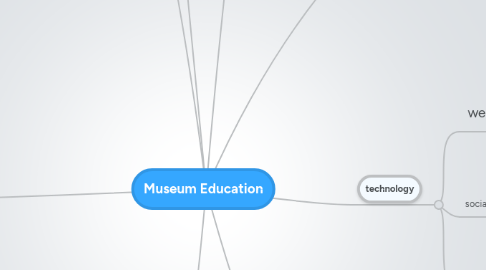
1. informal Gallery Learning
1.1. exhibition collaboration
1.1.1. incorporating educational components from begining
1.2. didactic materials
1.2.1. labeling
1.2.2. technology
1.2.2.1. podcasts
1.2.2.2. online
1.2.3. interactive elements
1.3. inquiry based
1.3.1. guest interpretation
1.3.2. suggestive questions
1.3.3. where to go for more information
1.3.4. comments
1.4. creativity activities
1.4.1. sketching materials
1.4.2. craft stations
2. Partnerships
2.1. collaboration
2.1.1. collaboration with other museums
2.1.1.1. in state
2.1.1.2. in region
2.1.1.3. in US
2.1.1.4. worl-wide
2.1.2. collaboration with other arts organizations
2.1.2.1. oprea
2.1.2.2. dance
2.1.2.3. theatre
2.1.3. collaboration with businesses
2.1.3.1. team building
2.1.3.2. new ways to approach problems
2.1.3.3. cultural
2.1.4. collaboration with charities
2.1.4.1. health
2.1.4.2. children & family
2.1.4.3. animal welfare
2.1.5. collaboration with colleges
2.1.5.1. art appreciation
2.1.5.2. curriculum related
2.1.5.2.1. the business of art
2.1.5.2.2. the art of France in the 1600's
2.1.5.3. internships
2.1.5.3.1. develop program
2.1.5.3.2. supervise
3. Schools
3.1. virtual tours
3.1.1. curriculum based
3.1.1.1. "math and art"
3.1.1.2. "science of art"
3.1.1.3. "the art of arizona"
3.1.2. how a museum works
3.1.2.1. museum careers
3.1.2.2. what is conservation
3.1.2.3. New node
3.1.3. masterworks
3.1.3.1. museum masterpieces
3.1.3.2. genre
3.1.3.2.1. sculpture
3.1.3.2.2. paintings
3.1.3.2.3. 3-d art
3.1.3.2.4. digital/video
3.1.3.2.5. photography
3.1.3.2.6. drawings
3.1.4. fundamentals of art
3.1.4.1. what are we looking at?
3.1.4.2. art history
3.1.4.3. why did the srtist choose__?
3.2. teacher collaboration
3.2.1. training
3.2.1.1. how to use museum resources
3.2.2. curriculum
3.2.2.1. tours based on class subjects
3.2.2.2. exhibition planning
3.2.3. incorporation of common language
3.2.4. Networking
3.2.4.1. "teacher nights"
4. research
4.1. visitor behavior
4.1.1. observation
4.1.1.1. what are guests using?
4.1.1.2. time spent at exhibits
4.1.1.3. who are our visitors?
4.1.2. pre/post testing
4.1.2.1. effectiveness of resources
4.1.3. interviews
4.1.3.1. guest response to exhibit
4.1.3.2. why did guest visit?
4.1.3.3. satisfaction
4.1.3.4. what would community like to see at museum?
4.2. best practices in field
4.2.1. regualr interaction with other museum educators
4.2.2. continued education
4.2.3. attending conferences
4.3. collection
4.3.1. collaboration with curatorial staff on what needs additional research to meet needs of visitors
4.4. publications
4.4.1. materials for schools
4.4.2. collaboration of exhibition materials
5. technology
5.1. website resources
5.1.1. research
5.1.2. online gallery
5.1.3. post-visit additional information
5.2. social media
5.2.1. twitter
5.2.2. facebook
5.2.3. blogs
5.3. "virtual" visit
5.3.1. podcasts
5.3.2. video lectures
6. Classes
6.1. studio classes
6.1.1. how to sketch
6.1.2. color theory
6.1.3. photography
6.2. preschool age
6.2.1. Learn how to "see"
6.2.1.1. animal safari
6.2.1.2. games
6.2.2. hands on
6.2.2.1. handling collection
6.2.2.2. dress up like___
6.2.2.3. studio art
6.2.3. parent education
6.2.4. story telling
6.3. child
6.3.1. art camp
6.3.2. saturday school
6.3.3. homeschool
6.4. teen
6.4.1. (also see studio classes)
6.4.2. teen night in museum
6.4.2.1. teen-themed
6.4.2.1.1. movies
6.4.2.1.2. music
6.4.2.1.3. fashion
6.4.3. technology
6.5. Senior Workshop
6.5.1. look at object then use similar media
6.5.2. create work in style of _____
7. Touring
7.1. public tours
7.1.1. art history
7.1.1.1. understanding modern art
7.1.1.2. the art of the renaissance
7.1.1.3. all about Picasso
7.1.2. object of the month
7.1.3. masterworks of the museum
7.2. docents
7.2.1. training
7.2.2. supervision
7.2.3. development of tours
7.3. school tours
7.3.1. tours
7.3.1.1. curriculum based
7.3.1.2. fundamentals of art
7.3.1.3. inquiry based
7.3.2. written resources
7.3.2.1. worksheets
7.3.2.2. scavenger hunts
7.4. seniors
7.4.1. tours
7.4.1.1. accessable
8. Community, Adult & Family
8.1. adult night out
8.1.1. Films
8.1.2. Lecture Series
8.1.3. Wine events
8.2. community needs
8.2.1. current issues
8.2.1.1. how art relates to local issues
8.2.1.2. community activism
8.2.2. support and promotion of local artists
8.2.2.1. exhibition space
8.2.2.2. social events
8.2.3. reaching non-traditional, diverse audience
8.2.3.1. branch locations
8.2.3.1.1. Art-Mobile
8.2.3.1.2. loans
8.2.3.2. transportation
8.2.3.3. events
8.2.3.3.1. specific for underserved populations
8.3. senior education
8.3.1. in community
8.3.1.1. virtual tours
8.3.1.1.1. thematic
8.3.1.1.2. art history
8.3.1.1.3. art object talks
8.3.1.2. studio classes
8.3.1.2.1. painting
8.3.1.2.2. how to draw
8.3.1.2.3. ceramics
8.3.1.2.4. crafting
8.3.2. develop resources
8.3.2.1. use in care facilities
8.3.2.2. using art to improve memory
